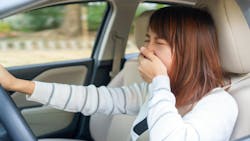The dental hygienist’s role in screening for sleep apnea
It is estimated that 23 million adults in the United States have undiagnosed or untreated moderate to severe obstructive sleep apnea.1 Hygienists are often taught that we have a limited role in identifying systemic conditions in patients. Since we’re not able to diagnose oral diseases and conditions we’re highly educated about, what can we do about systemic conditions we suspect in patients? When it comes to obstructive sleep apnea (OSA), sleep-disordered breathing (SDB), and upper airway resistance syndrome (UARS), there are several ways we can play an integral role in assessing and identifying (not diagnosing) key signs and symptoms of these diseases.
SDB is a multifactorial spectrum of sleep-related conditions, including increased resistance to airflow through the upper airway (UARS), heavy snoring, a reduction in overall airflow (hypopnea), or complete cessation of breathing (apnea).2 Historically, we’ve been taught that the main signs of OSA include snoring and daytime sleepiness.
While these are certainly concerning factors to include in your assessment, there are several other researched evaluation criteria hygienists should watch for and discuss with patients. These include xerostomia; redness of the soft palate and uvula areas due to mouth breathing; bilateral mandibular tori; bruxism signs such as occlusal wear and fractured teeth; and a narrow and vaulted palate and retrusive jaw development associated with tethered oral tissues. More chronic symptoms of OSA include depression, frequent nighttime waking and urination, acid reflux/GERD, and concentration and memory difficulties.3
Additionally, adenotonsillar hypertrophy (enlarged tonsils) is a widely recognized risk factor for OSA.4 Enlarged tonsils, along with constricted and elongated facial growth combined with posterior crossbites and crowded teeth, are a major indication of airway resistance. This atypical orofacial growth pattern is termed “adenoid face” because it’s so prevalent in the airway disorders community.1
You might also want to read: Do ortho extractions lead to SDB or OSA?
What hygienists can do
RDH-guided screenings to assess a patient’s risk for airway disorders include determining a patient’s Mallampati score, and having them complete a STOP-bang questionnaire, a pediatric sleep questionnaire, or the Epworth sleepiness scale, depending on the patient’s age. A Mallampati score of three or four typically places a patient at an increased risk of OSA, but further testing by a physician is highly recommended, including a diagnostic sleep test.5
The STOP-bang questionnaire is a yes/no screening used to quickly assess a patient's risk for OSA based on snoring, tiredness, observed apnea, blood pressure, body mass index, age, neck size, and gender.6 The Epworth sleepiness scale measures a patient's average sleep propensity (ASP) across a wide range of activities of daily living to determine their level of daytime sleepiness.7
Additional systemic complications associated with SDB include hypertension, abnormal cholesterol levels, high blood sugar levels, and an increased waist circumference—all of which are linked to metabolic syndrome—along with cardiovascular conditions such as heart arrhythmia.8
Children experiencing sleep disruption due to SDB may have symptoms ranging from snoring and irritability to bedwetting, slow growth (failure to thrive), cardiovascular difficulties, struggles with obesity, and/or learning and behavioral difficulties like ADHD that are often due to apnea-associated oxygen desaturation and sleep disturbances.9
So, what is the RDH's main role in screening for these signs and symptoms of sleep apnea or airway restrictions? Patient education. Although we’re not able to diagnose conditions and diseases, we’re still health-care providers who spend more time with our patients than most medical doctors. We often build close relationships with our patients, which gives us a unique opportunity to take a deep dive into their symptoms and lifestyle habits that could be contributing to the risks of SDB.
A general understanding of what to watch for clinically and how to discuss your concerns with patients is the first step in identifying often undiagnosed (or misdiagnosed) high-risk patients. If you’re not fully comfortable discussing a patient’s risks, a great starting point is to include assessments of tonsil size, the Mallampati score, and chairside sleep-related questionnaires for each patient that can be used to screen them for referral to sleep specialists.
By having an open dialogue with our patients about what we see clinically that could indicate a potentially deadly systemic condition, we open the door to our patients to see us as whole-body providers instead of just “teeth cleaners.” Patients receive elevated oral and systemic care, and it’s a win-win for everyone!
References
- Gianoni-Capenakas S, Gomes AC, Mayoral P, Miguez M, Pliska B, Lagravere M. Sleep-disordered breathing: the dentists’ role—a systematic review. J Dent Sleep Med. 2020;7(1)
- Sleep disordered breathing. American Thoracic Society. https://qol.thoracic.org/sections/specific-diseases/sleep-disordered-breathing.html
- Kandray DP, Yacovone M. Screening for obstructive sleep apnea. Dimen Dent Hyg. 2010;8(3):54-57.
- Paruthi S. Evaluation of suspected obstructive sleep apnea in children. UpToDate. April 15, 2022. https://www.uptodate.com/contents/evaluation-of-suspected-obstructive-sleep-apnea-in-children/print
- Summer J. Mallampati score and predicting sleep apnea. Sleep Foundation. August 17, 2022. https://www.sleepfoundation.org/sleep-apnea/mallampati-score
- Pivetta B, Chen L, Nagappa M, et al. Use and performance of the STOP-bang questionnaire for obstructive sleep apnea screening across geographic regions: a systematic review and meta-analysis. JAMA Network. 2021;4(3):e211009. doi:10.1001/jamanetworkopen.2021.1009
- Johns M. About the ESS. The Epworth Sleepiness Scale. https://epworthsleepinessscale.com/about-the-ess/
- Sleep apnea. Mayo Clinic. https://www.mayoclinic.org/diseases-conditions/sleep-apnea/symptoms-causes/syc-20377631
- Pediatric sleep-disordered breathing. ENT Health. December 2018. href="https://www.enthealth.org/conditions/pediatric-sleep-disordered-breathing/">https://www.enthealth.org/conditions/pediatric-sleep-disordered-breathing/
About the Author

Liz Laney, BSDH, RDH
Liz Laney, BSDH, RDH, has been active in the dental field for 12 years, eight as a practicing RDH. She has experience and advanced education in infection control, dental hygiene policy and procedure creation and implementation, periodontics, and orofacial myofunctional therapy. Liz’s biggest passion is creating systems that help patients identify signs and symptoms of oral and systemic dysbiosis, then working with them to create lifestyle changes to improve their whole-body health status.
